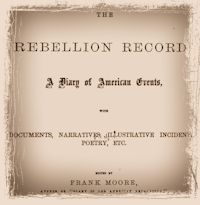October 15.—Governor Vance, of North-Carolina, issued an appeal to the people of that State, in which he said, that, “after the most strenuous exertions on the part of its officers, the State finds it impossible to clothe and shoe our soldiers without again appealing to that overflowing fountain of generosity—the private contributions of our people,” and asking that all possible contributions be made. “A great lot of blankets, also, might yet be spared from private use, and thousands could be made from the carpets on our parlor floors.”—(Doc. 8.)
—The bark Lamplighter, of Boston, Captain Harding, from New-York to Gibraltar, was this day captured in latitude 41° 30′, longitude 59° 17′, by the rebel privateer Alabama, and burned.
—The Right Reverend John H. Hopkins, Episcopal Bishop of Vermont, addressed a letter to the House of Bishops, assembled in General Convention at New-York, protesting against the political aspect of the Pastoral Letter adopted by that body.—See Supplement.
—The Bridgeport (Second Connecticut) battery, one hundred and sixty-five men, under the command of Captain John W. Sterling, arrived at New-York en route for the seat of war. Of the one hundred and sixty-five men comprised in this corps, one hundred and thirty-seven are from amongst the most active business men of Bridgeport— General McClellan made a preliminary report of the military operations under his charge since the evacuation of Harrison’s Landing, Va, — (Doc. 2.)
— Drafting in Boston commenced to-day, under the supervision of Judge Russell, Commissioner, aided by Sheriff Clark, and Dr. N. W. Shurtleff, who was blindfolded and drew the names from a box.—At Baltimore, Maryland, the draft was also made, only forty men being required to fill the quota of that city.—A force of rebel troops under the command of Colonels Anderson, Johnson, and Martin, captured the steamer Hazel Dell at Caseyville, Kentucky.
—An expedition of armed boats from the blockading fleet at Apalachicola, Florida, proceeded up the Apalachicola River, and, after a sharp contest with a rebel force, drove them back and captured a schooner laden with cotton preparatory to running the blockade. Upon returning, the expedition was fired upon by a party of rebels at Apalachicola, when the town was shelled and set on fire.—(Doc. 86.)
—A skirmish took place in the vicinity of Carsville, Virginia, between a company of the Seventh Pennsylvania cavalry, under the command of Lieutenant Williams, and a force of rebels in ambush, resulting in the killing and wounding of several of the Nationals.—Acting Master Frederick Crocker, of the United States steamer Kensington, made an expedition from Sabine Pass, Texas, up the river, and destroyed the large railroad bridge at Taylor’s Bayou, put to flight a body of rebels, and burned their encampment and two rebel schooners.—(Doc. 7.)



